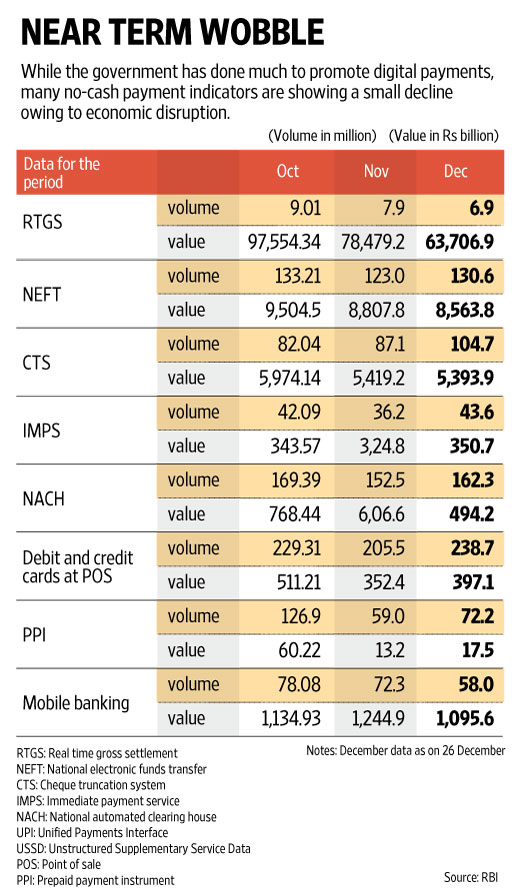Demonetisation and after
Prime Minister Narendra Modi’s bold move to invalidate 86% of currency (by value) in circulation has been widely debated. Some call it politically astute but economically unwise. In the near term, it has thrown life out of gear and disrupted the economy. The jury is still out on what the long-term consequences are. There is a lot of uncertainty on the second-round economic impact and how long it will last, but one thing is certain: India is on an irrevocable path to a less-cash society.
The decision: A one-time shock
—The government decides to invalidate Rs500 and Rs1,000 currency notes from 9 November to combat black money, fake currency and terror finance.
—The public is given time till 30 December to exchange or deposit their old currency notes with banks.
—The government and the Reserve Bank of India (RBI) impose limits on withdrawal from banks and automated teller machines (ATMs).
—Initially, specific exemptions are allowed for a few days and use of the old high-value notes is allowed at government hospitals, petrol pumps, and buying rail and air tickets, and so on.

economic affairs secretary Shaktikanta Das (left) and RBI governor Urjit Patel unveil the new Rs2,000 note on 8 November. Photo: HT
Immediate consequences: Withdrawal symptoms
—With about 86% of currency in circulation no longer legal tender, people’s lives are thrown out of gear as they queue up for new currency notes and to deposit old ones.
—The government and the Reserve Bank of India (RBI) are unprepared to deal with the consequences. A Right to Information (RTI) query reveals that RBI had just one-fourth of the Rs20.5 trillion worth stock of old notes in new replacement notes.

Photo: Pradeep Gaur/Mint
—A series of central bank notifications are issued as firefighting measures—a special dispensation for weddings and current account withdrawals are introduced.
—Several measures are reversed later. One example: on 11 November, RBI said people need not crowd bank branches as they can exchange cash at their own convenience. On 24 November, it said that no more exchange facilities will be allowed at bank branches.
ALSO READ | RBI gets its messages mixed with 50 notifications in 30 days
—The first round of economic fallout is seen in those businesses which are heavily cash-dependent.
—Supply chains are disrupted in industries such as packaged consumer goods; corner stores see a sharp decline in footfalls and two-wheeler sales dip 5.8% in November.
—The fall in consumption has a salubrious effect on inflation; retail inflation falls to 3.63% on November.
—Several brokerages and multilateral institutions, such as the Asian Development Bank, pare their economic growth estimates for India.
—demonetisation puts incredible power in the hands of bank officials. Several bank officials are arrested on suspicion that they connived in money laundering and illegally converted old notes to new.
ALSO READ | How demonetisation has impacted key sectors
—The government introduces a new income disclosure scheme; tax evaders are given time till 31 March under the Pradhan Mantri Garib Kalyan Yojana.
—The government unveils a series of measures to encourage digital payments. It offers discounts on petrol, railway tickets, toll payments and insurance policies; asks banks to waive fees on debit and credit cards; tells bank to install an additional one million point of sales (PoS) terminals in three months and introduces a lucky draw for digital payment users.
—Banks become flush with liquidity and RBI temporarily increases the percentage of cash banks deposit with it to deal with excess liquidity; later, the limits on so-called market stabilization scheme bonds are increased. Banks are likely to cut deposit rates as well.
—RBI allows lenders including banks, non-bank financial institutions and micro lenders an additional 60 days to classify defaults as non-performing loans.
Aftermath: Uncertainty persists

Photo: Reuters
—There is still uncertainty about the economic impact of demonetisation. Will the economy revert to normal in one quarter or two? Even the central bank’s monetary policy committee is uncertain: it has penciled in a 15 basis points impact on the third-quarter gross value added (GVA).
—What will be the impact on economic growth for this financial year? Economist forecasts range from 50 basis points to 330 basis points impact on the GDP growth. One basis point is one-hundredth of a percentage point.
—The government has issued an demonetisation ordinance which says holding invalidated notes in excess of Rs5,000 will be punishable.
—Till 19 December, about Rs12.44 trillion of old notes had come back.
—Will the difference—the notes that haven’t come back—be a windfall for the government?


Comments
Post a Comment